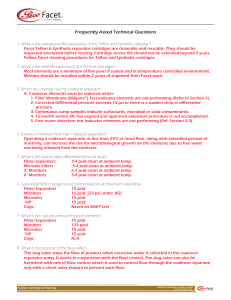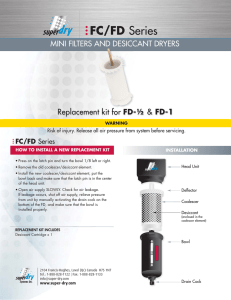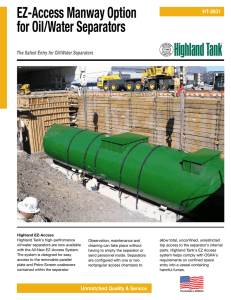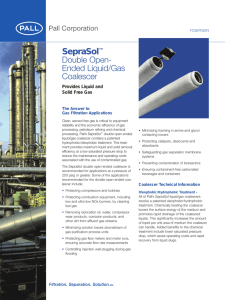faq-technical
advertisement
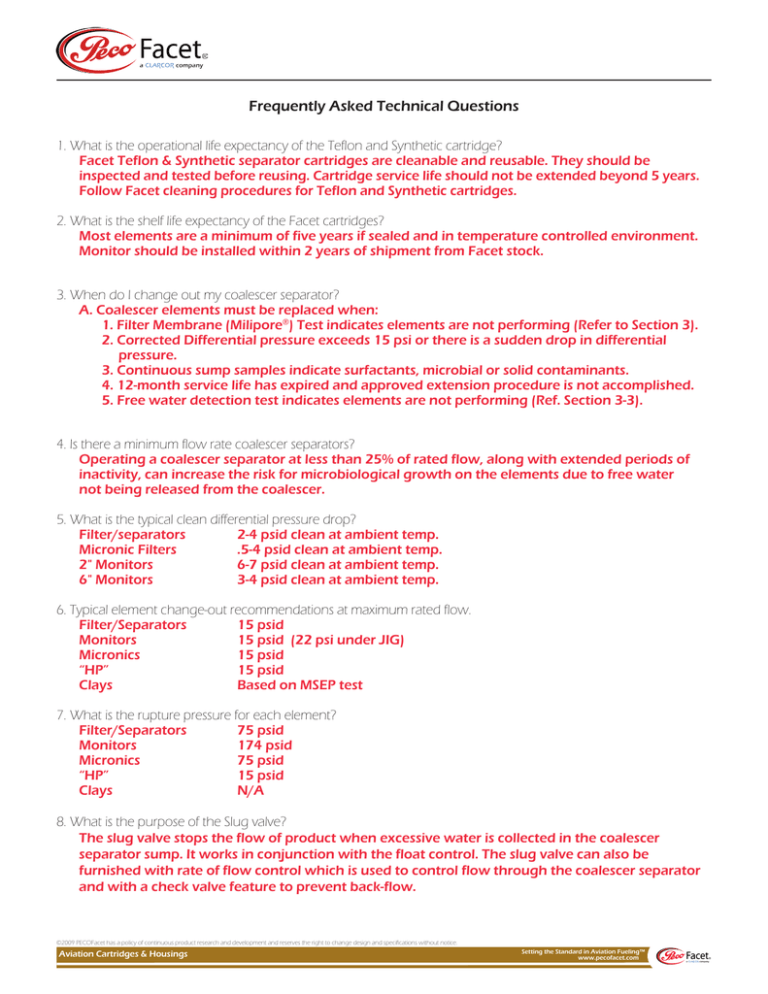
Frequently Asked Technical Questions 1. What is the operational life expectancy of the Teflon and Synthetic cartridge? Facet Teflon & Synthetic separator cartridges are cleanable and reusable. They should be inspected and tested before reusing. Cartridge service life should not be extended beyond 5 years. Follow Facet cleaning procedures for Teflon and Synthetic cartridges. 2. What is the shelf life expectancy of the Facet cartridges? Most elements are a minimum of five years if sealed and in temperature controlled environment. Monitor should be installed within 2 years of shipment from Facet stock. 3. When do I change out my coalescer separator? A. Coalescer elements must be replaced when: 1. Filter Membrane (Milipore®) Test indicates elements are not performing (Refer to Section 3). 2. Corrected Differential pressure exceeds 15 psi or there is a sudden drop in differential pressure. 3. Continuous sump samples indicate surfactants, microbial or solid contaminants. 4. 12-month service life has expired and approved extension procedure is not accomplished. 5. Free water detection test indicates elements are not performing (Ref. Section 3-3). 4. Is there a minimum flow rate coalescer separators? Operating a coalescer separator at less than 25% of rated flow, along with extended periods of inactivity, can increase the risk for microbiological growth on the elements due to free water not being released from the coalescer. 5. What is the typical clean differential pressure drop? Filter/separators 2-4 psid clean at ambient temp. Micronic Filters .5-4 psid clean at ambient temp. 2" Monitors 6-7 psid clean at ambient temp. 6" Monitors 3-4 psid clean at ambient temp. 6. Typical element change-out recommendations at maximum rated flow. Filter/Separators 15 psid Monitors 15 psid (22 psi under JIG) Micronics 15 psid “HP” 15 psid Clays Based on MSEP test 7. What is the rupture pressure for each element? Filter/Separators 75 psid Monitors 174 psid Micronics 75 psid “HP” 15 psid Clays N/A 8. What is the purpose of the Slug valve? The slug valve stops the flow of product when excessive water is collected in the coalescer separator sump. It works in conjunction with the float control. The slug valve can also be furnished with rate of flow control which is used to control flow through the coalescer separator and with a check valve feature to prevent back-flow. ©2009 PECOFacet has a policy of continuous product research and development and reserves the right to change design and specifications without notice. Aviation Cartridges & Housings Setting the Standard in Aviation Fueling™ www.pecofacet.com 9. What is the operation of a Water Probe? The water probe detects the level of water electronically and then can open and close the auto water drain valve or slug valve, shut down pump and send alarm to control panel. 10. What is the reason for a Clay Treater? The clay treater removes surfactants from fuel to allow coalescer separators to perform properly. The surfactants will disarm the coalescer elements. 11. What is the function of the vessel heaters? The heater keeps water from freezing in the sump and drain lines. 12. What data do you need to know to size a vessel? Refer to Application Data Sheet in your catalog. 13. Which should be used, clay bags or canisters? Canisters have gaskets that improve sealing and have less chance of bypassing. Bags, on the other hand, hold more clay and cost about 40% less. 14. Can clay bags be used in Velcon vessels? Not usually. Velcon vessels are built similar to “M” series filter vessels except without adaptors for cartridge sealing. They use center rods, center seals, and end caps. There are conversion kits but are cost prohibitive. Two things to remember, this can be a tremendous selling tool for Facet vessels, but it does add additional cost. 15. What colors are used for what fuels? Jet - Clear, AV Gas - Blue, High Sulfur Diesel - Red. 16. Can dye (color) in fuels be removed? In most instances, “no.” 17. Why use horizontal versus vertical housing? Space and ease of maintenance. 18. Should a filter be installed upstream of a coalescer separator? Depends on the application. If the customer is having a problem with solids you should definitely have a micronic filter in front of your coalescer separator. The micronic filter is anywhere from a third to a fourth of the cost and has four times the surface area. 19. How do we test for water? Aquaglo test (Jet Fuel only, Free Water). Karl Fisher measures total water or Shell Water Dector. 20. What is the difference between free and entrained and dissolved water? 1. Free water is created when the fuel has all the water it can dissolve plus more. This extra water is then free water. Free water is usually not visible as a haze until you get above 30 to 40 ppm free water. This free water is all that a coalescer or absorbent cartridge can remove. 2. Entrained water: Discrete water droplets carried by a continuous liquid or gas phase when water is immiscible with the liquid. May be separated from the continuous phase by coalescing and gravity separation. Usually picked up in a system by condensation or a water washing used in process. 3. Dissolved water is the water that is in solution or basically not visible in the fuel. The amount changes with temperature. Fuel holds more water as the temperature increases. ©2009 PECOFacet has a policy of continuous product research and development and reserves the right to change design and specifications without notice. Aviation Cartridges & Housings Setting the Standard in Aviation Fueling™ www.pecofacet.com 21. Can you convert a coalescer separator to a monitor unit? Yes. However, if the system pressure can exceed 115 psi, some type of surge suppressor would need to be installed upstream. Consideration should be given to relieve high-pressure build up. 22. Which monitor cartridges would you use when converting a coalescer separator and why? Generally you would use the FGI series monitor elements. There are several (good) explanations for using this series. Here are a few of the more common reasons. First, all coalescer separator units have more coalescer stools than separators. Therefore, you would be able to achieve the flow rate that you are looking for. In some instances you could actually increase the flow of the vessel. Second, if again the flow can be met with either, you will find that the ones most readily available will be the FGI series. 23. Is the delta P gauge on a clay treater actually telling you anything? Not really. This is a common misconception. The only true way to tell if the clay is working is to take a MSEP test. This test will be taken on the inlet and the outlet and compared. The reading from the outlet should be higher. A good quality fuel has a reading of 85 or better. The closer you get to 100 the better the fuel quality. If the fuel going in is 80 and the outlet is 80 or less, you would need to change out the clay. 24. How many pounds of solids does our MP series filter element hold? Up to 3-5 pounds per 14" length dependent upon the micron rating and type of solids present. 25. With AVGAS, can you flow more through the same coalescer separator? Yes. Approximately 20% more through the same unit. 26. What is the recommended sealing torque on screw base cartridges? 30 lbs. Ft. 27. What is the mesh size and micron rating of Facet’s Synthetic separator? 50 micron, 267 mesh. 28. What are the benefits of Facet’s CIF Cartridge? No metal components, less expensive while maintaining high efficiency of M Series elements and reduced disposal volume and cost. 29. How much water can monitors absorb? FGI 614 holds 800 milliliters FGO 614 holds 925 milliliters FG 230 holds 170 milliliters 30. Does the size of the water droplets indicate the coalescing efficiency? Downstream: Yes, the bigger the drops the more the fall. Saves Separator from having to do anything. 31. How is the gallon per minute of the coalescer calculated? Flow per linear inch which is based on EI test (Jet Fuel). 32. Can our immersion heaters be wired for a signal light? Yes. 33. Which cartridges should be used in converting a coalescer separator to a monitor? The appropriate lengths can be used on either the coalescer stools or separator stools. The FG-0 monitor must be installed on the separator stools and the FG-I monitor must be installed on the coalescer stools unless the flow is reversed. ©2009 PECOFacet has a policy of continuous product research and development and reserves the right to change design and specifications without notice. Aviation Cartridges & Housings Setting the Standard in Aviation Fueling™ www.pecofacet.com 34. Why are coalescer separators being modified to use monitors? To increase flow rate, less expensive, no single element test, no water detection sensor needed and assures dry fuel. Fail safe feature. 35. What are certificates of similarity? To provide certificate of test data in similar type vessels using flow rates that determine the correct amount of coalescers and separators. Upgrading an older vessel to EI 1581 current edition or changing from competitor vessel to Facet. 36. What are Monitor Certifications? Monitor Certificates are designed to document that the element and vessel configuration in place is capable of meeting EI 1583 performance standards. 37. Are Material Safety Data Sheet (MSDS) required for the products manufactured by Facet? Items manufactures by Facet are considered “articles” by definition of the regulations and therefore do not need MSDS sheets. 38. What is the correct procedure for draining the sump on a coalescer separator? Per ATA-103 guidelines, drain fuel at maximum practical flow into a suitable container. The vessel must be pressurized, but fuel does not have to be flowing. ©2009 PECOFacet has a policy of continuous product research and development and reserves the right to change design and specifications without notice. Aviation Cartridges & Housings Setting the Standard in Aviation Fueling™ www.pecofacet.com
